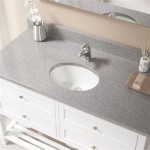Can You Use Acrylic Latex Paint in Bathrooms?
Bathrooms, with their high humidity and frequent exposure to water, present a unique challenge for painting. While traditional oil-based paints were once the standard choice for bathroom walls, acrylic latex paints have emerged as a popular and practical alternative. This article explores the feasibility of using acrylic latex paint in bathrooms, highlighting its advantages, limitations, and key considerations for successful application.
Advantages of Acrylic Latex Paint in Bathrooms
Acrylic latex paints offer a compelling combination of features that make them well-suited for bathroom environments. Their key advantages include:
- Water-Based Formula: Acrylic latex paints are water-based, making them significantly less toxic than oil-based paints. This is a major benefit in a confined space like a bathroom, as it reduces VOC (Volatile Organic Compound) emissions and creates a healthier indoor environment.
- Fast Drying Time: Latex paints dry quickly, typically within a few hours. This allows for efficient painting and minimizes disruption to bathroom usage.
- Easy Cleanup: Water-based latex paints can be easily cleaned up with soap and water, eliminating the need for harsh solvents. This simplifies the painting process and minimizes the risk of paint spills damaging surrounding surfaces.
- Durability: Modern acrylic latex paints are engineered for durability, offering good resistance to mildew, moisture, and abrasion. This makes them suitable for high-traffic areas like bathrooms.
- Variety of Finishes: Acrylic latex paints are available in a wide range of finishes, including matte, satin, semi-gloss, and gloss. This allows homeowners to choose the appropriate finish for their desired aesthetic and level of sheen, catering to different bathroom styles.
Limitations of Acrylic Latex Paint in Bathrooms
While acrylic latex paints excel in several areas for bathroom use, it's important to acknowledge their limitations:
- Moisture Sensitivity: While durable, acrylic latex paints can still be susceptible to excessive moisture, especially in areas with poor ventilation. Direct water contact can lead to paint peeling, blistering, or mildew growth.
- Limited Mold Resistance: While some acrylic latex paints offer mildew-resistant properties, they are not inherently mold-proof. Mold growth can occur in areas with high moisture levels, even with mildew-resistant paints.
- Potential for Staining: Acrylic latex paints can be more susceptible to staining than oil-based paints, especially from waterborne stains like those caused by hard water or soap scum.
Key Considerations for Using Acrylic Latex Paint in Bathrooms
To maximize the success of using acrylic latex paint in bathrooms, consider the following crucial factors:
- Ventilation: Adequate ventilation is paramount. Ensure proper airflow by using exhaust fans, opening windows, or using a dehumidifier to combat humidity.
- Surface Preparation: Thorough surface preparation is essential for achieving a durable paint finish. This involves cleaning the walls to remove dirt, grime, mold, and mildew, then sanding to create a smooth, receptive surface for the paint.
- Primer: Apply a primer specifically designed for bathrooms or high-moisture areas. This creates a barrier against moisture penetration and helps the paint adhere more effectively.
- Paint Selection: Choose a high-quality acrylic latex paint formulated for bathrooms or high-moisture applications. Look for labels indicating mildew resistance, moisture resistance, and durability.
- Multiple Coats: Apply multiple thin coats of paint rather than one thick coat. This allows for even coverage, prevents drips, and enhances durability.
- Drying Time: Allow sufficient drying time between coats, following the manufacturer's recommendations. This ensures proper drying and prevents paint issues.
By carefully considering these factors and selecting the right paint product, homeowners can successfully utilize acrylic latex paint for a fresh and durable finish in their bathrooms.

What Kind Bathroom Paint Should I Use Ag Williams

Best Type Of Paint For Bathrooms 2024 Guide Forbes Home

Which Paint Should I Use In A Bathroom Victoriaplum Com

Latex Vs Acrylic Paint Differences Uses Advantages

Which Paint Should I Use In A Bathroom Victoriaplum Com

What Type Of Paint Works For A Bathroom Shower Bathwraps

Don T Use Just Any Old Paint On Bathrooms Ppc

Which Paint Should I Use In A Bathroom Victoriaplum Com

Best Paint For Bathroom Ceilings

How To Paint Bathroom Cabinets Diyer S Guide Bob Vila
Related Posts







